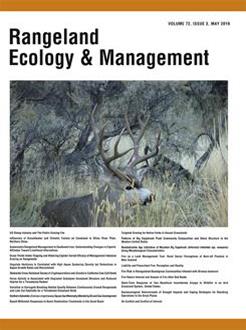Management intensive grazing (MIG) may not maximize plant productivity on rangelands because of morphophysiological traits of grassland vegetation. We examined defoliation and moisture effects on the biomass yield of rhizomatous and caespitose grass pairs that were either phylogenetically similar or of similar agroclimatic adaptation, including two agronomic grasses. From relatively low to high moisture regime adaptation, species pairs included western wheatgrass (Pascopyrum smithii [Rydb.] A. Love) and needle-and-thread (Hesperostipa comata [Trin. & Rupr.] Barkw.), northern wheatgrass (Elymus lanceolatus [Scribn. & J.G. Sm.]) and western porcupine grass (H. curtiseta [Hitchc.] Barkw.), plains and foothills rough fescue (Festuca hallii [Vasey] and F. campestris Rydb.), and smooth and meadow brome (Bromus inermis Leyss. and B. riparius Rehm). Response variables were shoot yield, root-shoot ratio, and water-use efficiency. We hypothesized that caespitose grasses, regardless of their origin or adaptation to agroclimate regime, would respond more determinately in biomass accumulation. Defoliation effects on shoot biomass were more pronounced under high moisture. Low intensity - high frequency defoliation yielded similarly to deferred controls in all grasses, and the same was true for high-intensity - low-frequency (HILF) defoliation in 1 rhizomatous grass. Three of the 4 rhizomatous grasses and 1 caespitose grass yielded greater under HILF defoliation compared with high-intensity - high - frequency defoliation. Caespitose grasses allocated more biomass to roots under low moisture conditions. Water-use efficiency decreased under high moisture conditions and more intense and/or frequent defoliation and peaked in agronomic grasses. Overall, our results suggested that growth patterns corresponded more with phylogenetic similarity as opposed to growth form. A conceptual model from these results showed that across all species, only the introduced bromes generated greater biomass under HILF defoliation, and this may explain why past research consistently concludes that MIG does not enhance plant productivity on rangelands.
How to translate text using browser tools
30 April 2019
Grass Yields Under Clipping and Watering Explain Varied Efficacy of Management Intensive Grazing on Rangelands
Tanner S. Broadbent,
Edward W. Bork,
Janice E. Cooke,
Walter D. Willms
ACCESS THE FULL ARTICLE

Rangeland Ecology and Management
Vol. 72 • No. 3
May 2019
Vol. 72 • No. 3
May 2019
caespitose
continuous
greenhouse
rhizomatous
rotational




